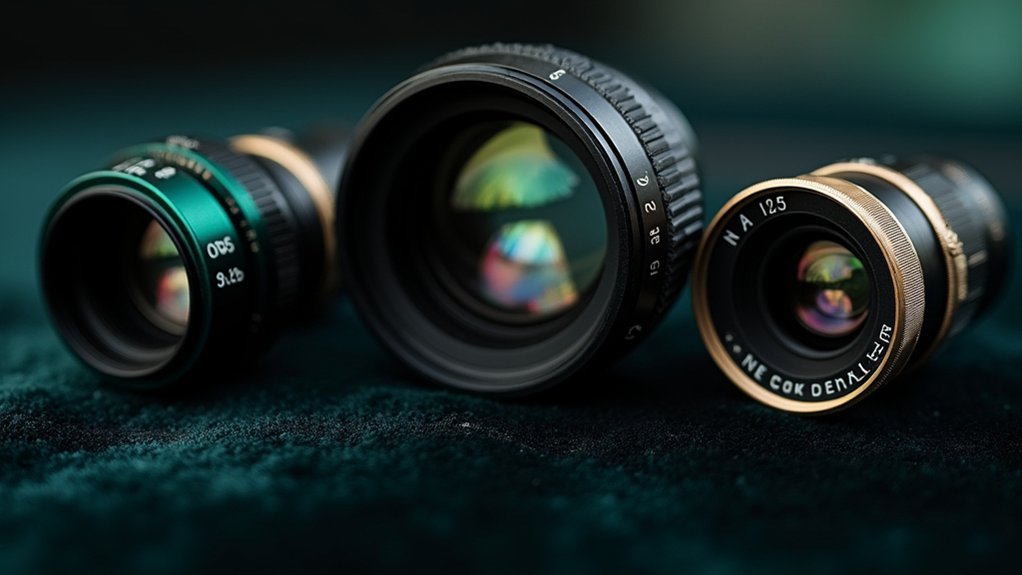The three best objective lens NA values for microscopy imaging are: high NA oil immersion objectives (1.25-1.4) for maximum resolution of subcellular structures, mid-range air objectives (0.65-0.95) for balanced routine imaging without oil, and low NA objectives (0.10-0.40) for wide-field specimen navigation. You’ll want to match your NA selection to your specific application needs—resolution requirements, working distance, and sample preparation complexity all influence your ideal choice. Discover how each NA range transforms your imaging capabilities.
High NA Oil Immersion Objectives (NA 1.25-1.4): Maximum Resolution for Cellular Details

When you need to visualize the finest cellular structures, high NA oil immersion objectives ranging from 1.25 to 1.4 provide unmatched resolving power.
These objectives utilize immersion oil with a refractive index of approximately 1.5 to minimize light refraction, dramatically improving light collection and image brightness.
Immersion oil’s 1.5 refractive index creates an optimal light path, enhancing image clarity and brightness for superior microscopic detail.
For peak results, you’ll need a thin 0.17 mm coverslip, which guarantees proper working distance and focus.
The increased angular aperture of these lenses allows you to resolve features as small as 200 nm—perfect for examining sub-cellular components that lower NA objectives simply can’t capture.
At 100x magnification, these objectives excel at revealing fine details within tissue structures that would otherwise remain invisible, making them essential tools for advanced microscopy applications requiring maximum resolution.
Mid-Range NA Air Objectives (NA 0.65-0.95): Balancing Performance and Practicality
For most routine microscopy, mid-range NA air objectives (0.65-0.95) represent the perfect compromise between resolution and practical usability. You’ll find these objective lenses offer sufficient light gathering capabilities to produce bright images while maintaining adequate resolution for distinguishing cellular features.
| Feature | Low NA (<0.65) | Mid-Range NA (0.65-0.95) | High NA (>0.95) |
|---|---|---|---|
| Resolution | Limited | Good | Excellent |
| Depth of Field | Deep | Moderate | Shallow |
| Working Distance | Long | Medium | Short |
| Sample Prep | Simple | Moderate | Complex |
These objectives are particularly valuable for live cell imaging where extended working distances prove beneficial. Unlike high-NA alternatives, they don’t require immersion oil, making them ideal for routine microscopy where quick sample changes are needed but reasonable resolution is still essential.
Low NA Objectives (NA 0.10-0.40): Wide Field of View for Scanning and Navigation

At the lower end of the numerical aperture spectrum, objectives with NA values between 0.10-0.40 serve as your essential tools for specimen navigation and large-scale survey imaging.
These low NA objectives provide the wide field of view you’ll need when scanning specimens and gaining overall context before detailed analysis.
You’ll appreciate their longer working distance, which facilitates easier specimen manipulation without losing focus. They excel in brightfield microscopy applications where illumination and contrast suffice for larger structures.
While their resolving power can’t capture fine details, they’re invaluable for whole specimen imaging.
Look for the color-coded 4× (red) and 10× (yellow) objectives on your microscope when you need these scanning and navigation capabilities—they’re your first step in systematic microscopic investigation.
Frequently Asked Questions
What Is the NA of an Objective Lens?
NA (Numerical Aperture) is your objective lens’s light-gathering capability, calculated as n*sin(θ). You’ll find typical NA values range from 0.1 (low-power) to 1.4 (high-power oil immersion lenses), directly affecting resolution and brightness.
What Is the NA Number Objective?
The NA number of an objective lens shows its light-gathering ability, ranging from 0.1 (low power) to 1.4+ (high-power oil immersion). You’ll find higher NAs provide better resolution for your microscopy work.
What Is the NA of 10X Objective Lens?
The NA of a 10x objective lens typically ranges from 0.25 to 0.3. You’ll find this moderate numerical aperture provides sufficient resolution while allowing adequate working distance for your standard low-magnification observations.
What Is a High NA Air Objective?
A high NA air objective is a lens you’ll use without immersion media, typically having NA values between 0.8-0.95. It offers better resolution and light collection than standard objectives while avoiding oil immersion complexity.
In Summary
You’ll find the right NA value makes all the difference in your microscopy work. Whether you’re using high NA oil immersion for maximum resolution, mid-range air objectives for everyday research, or low NA objectives for scanning larger areas, your choice should match your specific imaging needs. Remember, it’s not always about the highest NA—it’s about selecting the appropriate one for your application.





Leave a Reply